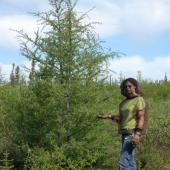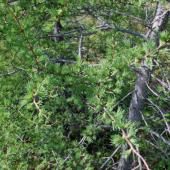Tamarack
Gwichya Gwich'in Name:
ts'iiteenjùh
Teetł’it Gwich’in Name::
tsiiheenjoh
Latin Name:
Larix laricina
People should leave an offering when collecting any part of a tamarack tree.
Caroline Andre of Tsiigehtchic said, “This is real good medicine. They say you have to pay for it, leave sugar or tea behind.”
As medicine
Tamarack tea is good for upset stomach, colds, fatigue, or for general good health. It is made by cutting tamarack branches into 15 centimeter (six inch) lengths, and boiling gently for five to 10 minutes, adding water as it evaporates. One can also add spruce gum to the tamarack stems and boil to make a stronger medicine. Mary Kendi of Fort McPherson made her special medicine by adding cut up pieces of birch fungus to the tamarack stems and boiling. According to Laura Pascal (COPE), the inner bark can be prepared as a poultice for wounds.
Source: Andre, Alestine and Alan Fehr, Gwich'in Ethnobotany, 2nd ed. (2002)
The bark, boughs and roots of the tamarack tree are made into a medicinal tea to treat serious colds.
Source: Andre, Alestine, Nant'aih nakwits'inahtsìh (The Land Gives Us Strength) (2006)
Source: Andre, Alestine, Nant'aih nakwits'inahtsìh (The Land Gives Us Strength) (2006)
As fuel
Dry tamarack wood produces a lot of heat when burned.
As tools
Tamarack roots are very strong and can be coiled and stored for later use.
Source: Andre, Alestine and Alan Fehr, Gwich'in Ethnobotany, 2nd ed. (2002)
Woody part of branch - Gwichya Gwich'in: thoo chàn, Teetł'it Gwich'in: thoo’ chan
Branch - Teetł'it Gwich'in: thoo’ chàa
Needles - Teetł'it Gwich'in: thoo’àa
Wood - Gwichya Gwich'in: troo, Teetł'it Gwich'in: troo





